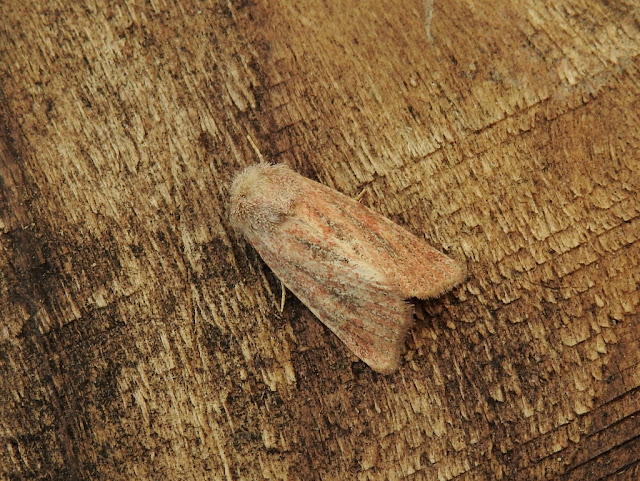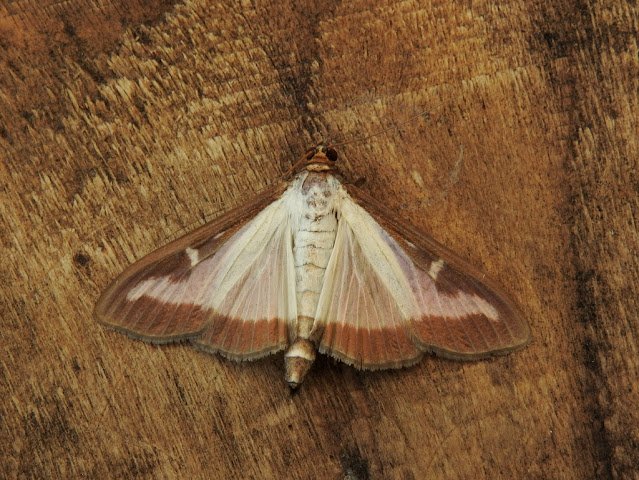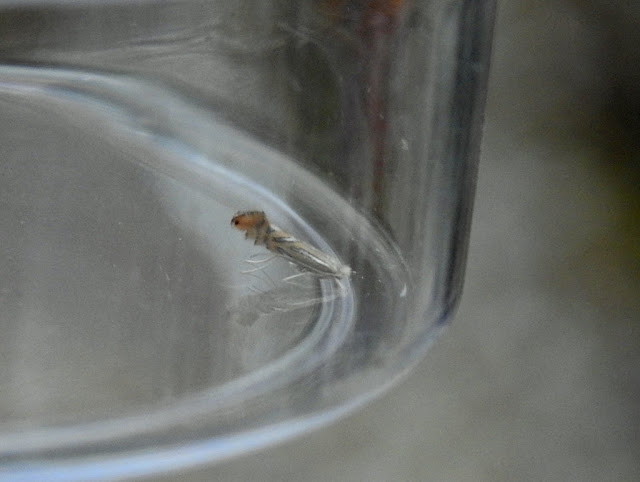Three days of fierce heat have finally relented, leaving a trail of carnage
and concern in their wake. In West Dorset it was unpleasant, but elsewhere I
expect stronger adjectives were used. Other people will go on about it far more
articulately than I ever could, so I'll talk about moths instead.
With the furnace of North Africa and Southern Europe spilling hot air this
way, moth folk were talking up the prospects. I am not really moth folk, but I
am an interested party, so I listened. Compared with Saturday night (48
moths of 29 species), Sunday was very busy - 170 moths of 63 species,
including 11 new ones...

|
Crassa unitella - becoming a familar face now.
|

|
Small Wainscot (new)
|

|
Marbled Green (new)
|

|
Maple Pug (new). Great to get a new pug, and another one which
doesn't seem to be recorded that much in the Bridport area.
|

|
Pebble Hook-tip (new) - three of these
|

|
Box-tree Moth (new) - much bigger than I imagined.
|

|
Dingy Shell (new) - apparently never rests with its wings
open.
|
As far as I can tell, there were no migrants in Sunday night's catch. Monday
perhaps?
Monday afternoon was baking. I knew that sleep might be elusive, and had no
intention of working on Tuesday, so decided to spend the night in the garden.
With the moths.
I had not anticipated what happens to the local invertebrate population when
the overnight temperature remains above 20 degrees Centigrade. It descends
upon the nearest moth trap, en masse. All night long, our little trap
was rattling like a set of maracas, and my face, hair, legs and arms all an
interesting diversion for a million insects bent on suicide. The final moth
tally was 179 of 82 species. Notably, the first Jersey Tigers made an
appearance, three in all. Compared to average moths, they look huge in
flight! They were one of 16 new species...

|
Ostrinia nubilalis (European Corn Borer). There
were five of this migrant species.
|

|
Sandy Carpet (new)
|

|
Just a single Udea ferrugalis (Rusty-dot Pearl) -
another migrant.
|

|
One of two Plutella xylostella (Diamond-back) - as far as I know, the only other migrants in Monday night's
catch.
|

|
Rosy Minor (new)
|

|
Four-spotted Footman (new) - four of these.
|

|
Yellow-tail (you don't say?) - also new.
|

|
Phyllonorychter platani
|
I wish I had managed better photos of that last one. Through a hand lens it is
just outrageous. Black-edged, silvery stripes on a grey-and-apricot body with a tufty, bright
orange fringe, all packed into about 4mm.
I didn't have time to finish off and identify everything, because I had once
again been invited to witness the emptying of half-a-dozen or so traps at
Mapperton, and needed to be there by 7am. Unfortunately I couldn't stay to the
end, but suffice to say it was fascinating. Among the many moths whose names
were as-yet unfamiliar to me, two Splendid Brocades caused a bit of
excitement. A pretty moth, and a pretty rare migrant too. I felt like the beginner
birder whose experienced companion finds a Lesser Yellowlegs or
something. It was great seeing the others enjoy the rarity buzz, but the value of
those smart moths was, in a sense, wasted on me.
However, I had no difficulty appreciating the contents of the
Lunar Hornet pheremone trap...

|
Lunar Hornet Moth - two of these beauties.
|
And so, to last night...
A rather excellent 140 moths of 75 species. More than I expected, especially
as the night was far from hot. Another 12 were new! Including this one...

|
Definitely past its best, but something about it rang alarm bells...
|
As soon as I saw this one in the trap, I was rapidly on it with a pot. It
reminded me of the three Bordered Straws I caught in June.
Bordered Straw is a quality migrant, and of course I had learned a few
things as a result of catching them. Like the fact that there are two, rarer, look-alikes.
Although very worn, this moth still
didn't look quite right for Bordered Straw, and sure enough, it was one of
the other two. Not the rarest, but I really didn't care. My first Scarce Bordered Straw added a nice bit of zing to the morning's
proceedings!

|
Dark Umber (new). Not ten-a-penny locally.
|

|
White-spotted Pug (new). Chuffed to add another pug to the
growing list.
|

|
Dun Bar (new) - far more attractive than its name.
|

|
Gothic (new). Very battered, but another one that is not common
locally, as far as I can tell.
|

|
Phoenix (new) - three of these.
|

|
Sharp-angled Peacock (new) - not quite pristine.
|
Finally, a couple of micros which illustrate why they are worth the effort.
Just stunning little things...

|
Acleris forsskaleana - just 7mm long.
|

|
This ridiculously loud little speck is the 3.5mm
Cameraria ohridella.
|
Hmm...
I've just had a quick read through the above, and I think it is fair to say that Not Quite Scilly is not quite what it
was.

























We seem to be traversing a very similar path, at present, not quite sure what's around the next corner? Really enjoyable post which certainly highlights the excitement of garden mothing when everything is still relatively new. What camera are you using for the micro moths? My old Canon set-up doesn't seem to be able to capture the detail that you're achieving. All the best - Dyl
ReplyDeleteThanks Dyl. Yes, the mothing is a blast, for sure, and it's great to know I'm in good company!
DeleteI'm using the Nikon P900's macro facility. I can get the zoom to go to about 105mm before it slips out of macro mode, which means I get quite decent magnification with the lens just a few cm from the subject.
Hi Gav - another great set of moths. The new ones will just keep coming, especially in this weather. You've already trapped a number of species that I've never seen and several that I've seen only rarely. Worth checking your Cloaked Minor which looks like a Rosy Minor, though it has been a number of years since I've seen one of those. I'm still thoroughly enjoying following your journey into the world of mothing and am excited to see what comes next. All the best. Matt
ReplyDeleteCheers Matt. The garden list is already 240+ in just a few weeks and, though the catch is never that big compared with many I read about, I've been surprised at the number of quality species (in a Dorset context) the trap has produced. Must be in a decent spot!
DeleteThanks for the heads-up re the minor. I will check it out. Must admit I hadn't considered Rosy. 😊 👍
PS. You were dead right about the minor of course - Rosy it is! Thanks for putting me straight. 👍
DeleteYou're getting great diversity in your trap Gavin. 270+ moths but 'only' 63 species on Tuesday night in my north Worcestershire garden. Three new, two of them micros, to take my garden list to c.330 after three years trapping. Picking perhaps a little slimmer in midlands than on the south-coast?! Cheers Mike
ReplyDeleteCheers Mike, that's interesting to hear. I am fortunate to live adjacent to some pretty decent habitat. There is a small river only 50m away, with associated mature trees etc, and I'm just three miles from the sea. Good to know you're still picking up new spp from time to time though... 👍
Delete